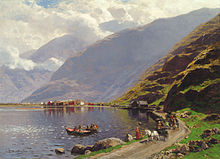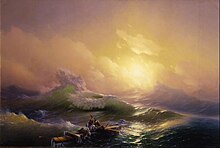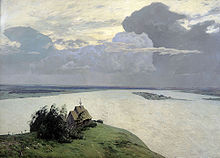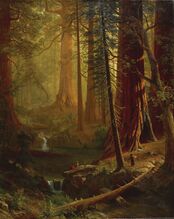Catherine Beaumonoir
Catherine Beaumonoir | |
|---|---|
 Self-portrait in 1819 | |
| Born | Katerina Mariya Ivanova August 10, 1794 |
| Died | March 24, 1856 (aged 61) |
| Nationality | Soravian |
| Known for | Leading portrait painter in Euclea |
Catherine Beaumonoir, also known by her birth name Catherine Maria Ivanova (Soravian: Катарина Мариыа Иванова; Katarina Mariya Ivanova; 10 August 1794 – 24 March 1856) was a prominent Soravian romantic and neoclassical artist and sculptor who specialised in portraits and seascape paintings. She spent most of her artistic career painting in the service of the courts of many royal houses of Euclea, including her birth country of Soravia, Gaullica and Estmere as well as countries abroad, painting portraits and seascapes of George Ruset Land, Nuxica and Cassier. Much of her work adorns the walls of museums in the modern day and her work is regarded as some of the best of the 19th century.
Beaumonoir was born in the port city of Lipa on Soravia's northern coast to her father, Ivan, a carpenter, and her mother Maria - from which Beaumonoir gets her middle name - who worked as a clothes maker but painted in her spare time. She spent much of her early life in Lipa where she developed her taste for natural seascapes, with some of her first paintings being landscape and seascape paintings of the town. She studied at a local school throughout her adolescent and early teenage years, before departing for university in Nikolagrad (modern day Paltamo, in Velzemia) when she was 16. She studied the painting techniques of other students in her first few weeks at the university before she became a student of famous painter and professor at the university Sergey Kholstoi, whom she learnt much of her early techniques and styles from.
Kholstoi tutored the young Beaumonoir until she was 18, where her artistic finesse and growing repertoir earned her a call up by the royal house of Nurukovich to begin painting portraits for some of the younger members of the family, notably future Emperor Ivan VI, who was 21 at the time. Ivan took an early liking to Beaumonoir during her portrait painting and the two communicated as friends, although it was concealed from the public to prevent the outbreak of a royal scandal. Beaumonoir painted three early portraits of Ivan in 1812, 1813 and 1815, all of which are hung in the Nuruk Palace in Samistopol.
Her most famous works, however, came towards the end of her Euclean career, Lipa in June - a cityscape of Lipa painted in 1827, is her most famous work, and is hung at the Beaumonoir Museum in Lipa, where it serves as its main attraction. She painted Ivan VI's 1829 coronation portrait, one of the most famous royal portraits in Euclea, and also painted various portraits for Gaullican and Estmerish royals throughout the 1820s and 30s, including Clovis Richard II and Charles I of Estmere, where she resided in a small apartment in Verlois. She departed Euclea for Asteria Superior in 1839, the same year she painted her last royal portrait. She focussed on landscapes and seascapes in Asteria Superior, and arrived in Carutagua in Nuxica in 1840 after painting Storms during a seastorm on her journey. She travelled through Nuxica, Cassier and as far as George Ruset Land to paint her newer landscapes, and, although less famous than her older painters, still garnered much attention throughout the Asterias, with her paintings being housed throughout the countries she travelled too.
Beaumonoir fell ill in 1855, and travelled back to Euclea to meet her family (whom she had kept regular contact with throughout her travels) who now lived in Hennehouwe, she arrived in the later December of 1855, days after the War of the Triple Alliance had concluded and Hennehouwe had achieved its independence. She died in the custody of her family in 1856 and her body was transported back to Soravia to be buried in Lipa. She now has various monuments throughout Soravia dedicated to her artworks, and had a museum opened in Lipa in her honour in 1880 to showcase her older artworks. The global veneration of her works makes her an extremely influential artist to this day, and one who encouraged the growth of the romantic painting style in the early 19th century.








